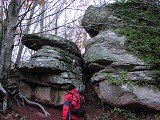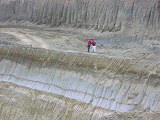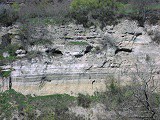Foglio 345 "Viterbo" della Carta Geologica d'Italia alla scala 1:50.000
 The geological sheet 345 "Viterbo" at the scale 1:50,000 is currently being prepared for printing. The sheet has been realized with a Research Contract between ISPRA and the University of Urbino, through the survey at 1:10.000 scale of the volcanic and sedimentary deposits on it, also using the cartography and data already existing at 1:25.000 scale. The activities also involved the acquisition of stratigraphic, sedimentological and structural data of the area, included in the documentation accompanying the sheet, such as Legend, geological sections, chronostratigraphic scheme, tectonic scheme and Explanatory Notes. ISPRA also took care of the computerization and preparation of the geological BD at 1:25.000 scale.
The geological sheet 345 "Viterbo" at the scale 1:50,000 is currently being prepared for printing. The sheet has been realized with a Research Contract between ISPRA and the University of Urbino, through the survey at 1:10.000 scale of the volcanic and sedimentary deposits on it, also using the cartography and data already existing at 1:25.000 scale. The activities also involved the acquisition of stratigraphic, sedimentological and structural data of the area, included in the documentation accompanying the sheet, such as Legend, geological sections, chronostratigraphic scheme, tectonic scheme and Explanatory Notes. ISPRA also took care of the computerization and preparation of the geological BD at 1:25.000 scale.
The areas occupied by sedimentary deposits were surveyed by the Tuscia University, while the areas occupied by volcanites were surveyed by the University of Urbino and ISPRA. In the part entrusted to ISPRA (SE quadrant of the sheet), all surveys and samples were carried out ex-novo. The area of Sheet no. 345 "Viterbo" is included in the sector of the western edge of the central Apennines affected by a sinorogenic compressive tectonic phase in the upper-middle Miocene and by an extensional phase from Messinian to Plio-Pleistocene. On a regional scale, this area is involved in the lifting of southern Tuscany and northern Latium, which can also be referred to the rising of magmatic melts.
 The main tectonic and volcanic-tectonic routes have a generally Apennine trend; later on, regional anti-Apennine horst and graben structures developed. The eastern sector of the Sheet is characterized by the very thick Plio-Pleistocene terrigenous successions deposited in the Paglia-Tevere Graben, well exposed in the area of the middle valley of the Tevere River. The sedimentary substrate is formed by the Mesozoic carbonates and the clastic complex consisting of flyschoid deposits and postorogenic deposits organized in two main sedimentary cycles.
The main tectonic and volcanic-tectonic routes have a generally Apennine trend; later on, regional anti-Apennine horst and graben structures developed. The eastern sector of the Sheet is characterized by the very thick Plio-Pleistocene terrigenous successions deposited in the Paglia-Tevere Graben, well exposed in the area of the middle valley of the Tevere River. The sedimentary substrate is formed by the Mesozoic carbonates and the clastic complex consisting of flyschoid deposits and postorogenic deposits organized in two main sedimentary cycles.
Along the discontinuities in the Mesozoic substrate (E-O, N-S and NO-SE fault systems) there has been the rise of silicatic melts that have fed an intense effusive activity from the lower Pleistocene and a still current hydrothermal activity. The outcropping volcanic deposits belong to three different Districts related to the volcanism of the Tuscan-Latium area characterized by the magmatic series with acid to intermediate compositions of the Tuscany Magmatic Province (Cimino Volcanic District, older) and by the potassic (prevalent in the VicanoVolcanic District) and ultrapotassic (prevalent in the VulsinoVolcanic District) of the Roman Comagmatic Province. In particular, the products from the activity of the centres of Bolsena and Montefiascone of the Vulsino District occur in the north-western sector of the Sheet, while in the southern one, the products of the Vicano District overlap the older products of the Cimino District. The Cimino Volcanic District (1.36 ÷ 1.29 Ma, Early Pleistocene) occupies the SE sector of the Sheet and is characterized by different phases of activity during which domi-lava, lava flows and ignimbritic deposits were put in place.
 The accurate surveying at the scale 1:10.000 and the new dating 40Ar-39Ar of the Cimino volcanites have improved the knowledge on the volcanic evolution of the District. The products of the Vulsino Volcanic District (576 ÷ 127 ka, Middle Pleistocene) are radially distributed with respect to the volcanic-tectonic depression occupied by the Bolsena Lake. The volcanic activity developed in correspondence both of central apparatus, with consequent formation of calderas, and of eruptive centres located along variously oriented fissural systems. Within the evolution of the Vulsino District, five volcanic complexes or "zones" have been distinguished, in which the mechanisms and eruptive scenarios were multiple, with an almost complete spectrum of explosive activities (Hawaiian, Strombolian, Plinian, Hydromagmatic and Surseyan). The activity of the Vicano District (about 500 ÷ 90 ka, Middle-Upper Pleistocene ) is referable to a central edifice with the typical shape of a strato-volcano whose top is truncated by a southward eccentric caldera. In the Sheet no. 345 "Viterbo" the northern peripheral part of the apparatus occurs, consisting mainly of wide ignimbrites. The evolution of the volcano of Vico can be schematized in four main phases. The initial phases are both explosive and effusive. The starting pyroclastic products are referable to a sequence of Plinian eruptions followed by an effusive activity with continuous stacking of lava flows. In the third phase the powerful pyroclastic formations known in literature as Ignimbriti A, B, C and D (Locardi, 1965) occur, linked to a highly explosive activity, eventually followed by a final phase mainly of hydromagmatic type. Volcanic and volcanoclastic deposits were associated, during the Pleistocene and the Holocene, with products of a predominantly gravelly-sandy nature of the continental sedimentary cycles of fluvial and fluvial-lacustrine environment, terraced and covered by travertine formations. The topic of this Sheet lies therefore in the complex reconstruction of the volcanic relationships between three different volcanic districts, variously interdigitated to the marine and transitional deposits of the Tyrrhenian Sea edge basin of the Paglia-Tevere and/or to the deposits of several alluvial cycles of the Tevere River. The survey was carried out on the basis of lithostratigraphic criteria, also analyzing the depositional facies and their associations.
The accurate surveying at the scale 1:10.000 and the new dating 40Ar-39Ar of the Cimino volcanites have improved the knowledge on the volcanic evolution of the District. The products of the Vulsino Volcanic District (576 ÷ 127 ka, Middle Pleistocene) are radially distributed with respect to the volcanic-tectonic depression occupied by the Bolsena Lake. The volcanic activity developed in correspondence both of central apparatus, with consequent formation of calderas, and of eruptive centres located along variously oriented fissural systems. Within the evolution of the Vulsino District, five volcanic complexes or "zones" have been distinguished, in which the mechanisms and eruptive scenarios were multiple, with an almost complete spectrum of explosive activities (Hawaiian, Strombolian, Plinian, Hydromagmatic and Surseyan). The activity of the Vicano District (about 500 ÷ 90 ka, Middle-Upper Pleistocene ) is referable to a central edifice with the typical shape of a strato-volcano whose top is truncated by a southward eccentric caldera. In the Sheet no. 345 "Viterbo" the northern peripheral part of the apparatus occurs, consisting mainly of wide ignimbrites. The evolution of the volcano of Vico can be schematized in four main phases. The initial phases are both explosive and effusive. The starting pyroclastic products are referable to a sequence of Plinian eruptions followed by an effusive activity with continuous stacking of lava flows. In the third phase the powerful pyroclastic formations known in literature as Ignimbriti A, B, C and D (Locardi, 1965) occur, linked to a highly explosive activity, eventually followed by a final phase mainly of hydromagmatic type. Volcanic and volcanoclastic deposits were associated, during the Pleistocene and the Holocene, with products of a predominantly gravelly-sandy nature of the continental sedimentary cycles of fluvial and fluvial-lacustrine environment, terraced and covered by travertine formations. The topic of this Sheet lies therefore in the complex reconstruction of the volcanic relationships between three different volcanic districts, variously interdigitated to the marine and transitional deposits of the Tyrrhenian Sea edge basin of the Paglia-Tevere and/or to the deposits of several alluvial cycles of the Tevere River. The survey was carried out on the basis of lithostratigraphic criteria, also analyzing the depositional facies and their associations.
 The recognizing of some volcanic markers within the successions allowed us to make some correlations with the stratigraphic discontinuity surfaces (erosional and/or non depositional) of major order defined in Tyrrhenian coastal areas in relation to the Pleistocene high frequency eustatic oscillations (De Rita et alii, 2002). These unconformities were then correlated with those identified by Mancini et alii (2003-2004) for the middle valley of the Tevere River, which were affected by the concurrence of several factors not exclusively dependent on coastal dynamics (volcano-tectonic, areas of local subsidence, development of the river system, etc.). In this way, the post-orogenic lithostratigraphic units represented in the Sheet have been inserted, where possible, into unconformity bounded stratigraphic (UBS) units (supersynthems and synthems) used in the legend as packages. These UBSUs provide a tool for stratigraphic synthesis and coordination with the adjacent geological sheets affected by the same geological events on a regional scale.
The recognizing of some volcanic markers within the successions allowed us to make some correlations with the stratigraphic discontinuity surfaces (erosional and/or non depositional) of major order defined in Tyrrhenian coastal areas in relation to the Pleistocene high frequency eustatic oscillations (De Rita et alii, 2002). These unconformities were then correlated with those identified by Mancini et alii (2003-2004) for the middle valley of the Tevere River, which were affected by the concurrence of several factors not exclusively dependent on coastal dynamics (volcano-tectonic, areas of local subsidence, development of the river system, etc.). In this way, the post-orogenic lithostratigraphic units represented in the Sheet have been inserted, where possible, into unconformity bounded stratigraphic (UBS) units (supersynthems and synthems) used in the legend as packages. These UBSUs provide a tool for stratigraphic synthesis and coordination with the adjacent geological sheets affected by the same geological events on a regional scale.
The result is summarized in the chronostratigraphic relationship scheme of the post-orogenic units and in the structure of the legend, which favour an integrated reading of times, depositional environments, nature of the deposits, volcanic centres, discontinuity surfaces, and allow to reconstruct the different geological phases that affected the area in which the three volcanic districts developed.
In the realization of the Sheet, some important stratigraphic news have emerged, among which the mapping of unpublished outcrops of some pyroclastic units, the recognition of new lava units, some of them with peculiar chemical-petrographic characteristics, the surveying of stratigraphical relations among the Cimino units, before not recognized; a 40Ar-39Ar dating campaign was carried out, which allowed to narrow the range of the Cimino District volcanic activity to less than 80 ka (Laurenzi et alii, 2014); moreover, on the basis of 232 stratigraphies of water wells, the paleo-morphology of the pre-Ignimbrite Cimina substrate was reconstructed and the thickness of this unit was estimated. Along the discontinuities in the Mesozoic substrate (E-O, N-S and NO-SE fault systems) there has been the rise of silicatic melts that have fed an intense effusive activity from the lower Pleistocene and a still current hydrothermal activity.
 The outcropping volcanic deposits belong to three different Districts related to the volcanism of the Tuscan-Latium area characterized by the magmatic series with acid to intermediate compositions of the Tuscany Magmatic Province (Cimino Volcanic District, older) and by the potassic (prevalent in the VicanoVolcanic District) and ultrapotassic (prevalent in the VulsinoVolcanic District) of the Roman Comagmatic Province. In particular, the products from the activity of the centres of Bolsena and Montefiascone of the Vulsino District occur in the north-western sector of the Sheet, while in the southern one, the products of the Vicano District overlap the older products of the Cimino District. The Cimino Volcanic District (1.36 ÷ 1.29 Ma, Early Pleistocene) occupies the SE sector of the Sheet and is characterized by different phases of activity during which domi-lava, lava flows and ignimbritic deposits were put in place. The accurate surveying at the scale 1:10.000 and the new dating 40Ar-39Ar of the Cimino volcanites have improved the knowledge on the volcanic evolution of the District. The products of the Vulsino Volcanic District (576 ÷ 127 ka, Middle Pleistocene) are radially distributed with respect to the volcanic-tectonic depression occupied by the Bolsena Lake. The volcanic activity developed in correspondence both of central apparatus, with consequent formation of calderas, and of eruptive centres located along variously oriented fissural systems.
The outcropping volcanic deposits belong to three different Districts related to the volcanism of the Tuscan-Latium area characterized by the magmatic series with acid to intermediate compositions of the Tuscany Magmatic Province (Cimino Volcanic District, older) and by the potassic (prevalent in the VicanoVolcanic District) and ultrapotassic (prevalent in the VulsinoVolcanic District) of the Roman Comagmatic Province. In particular, the products from the activity of the centres of Bolsena and Montefiascone of the Vulsino District occur in the north-western sector of the Sheet, while in the southern one, the products of the Vicano District overlap the older products of the Cimino District. The Cimino Volcanic District (1.36 ÷ 1.29 Ma, Early Pleistocene) occupies the SE sector of the Sheet and is characterized by different phases of activity during which domi-lava, lava flows and ignimbritic deposits were put in place. The accurate surveying at the scale 1:10.000 and the new dating 40Ar-39Ar of the Cimino volcanites have improved the knowledge on the volcanic evolution of the District. The products of the Vulsino Volcanic District (576 ÷ 127 ka, Middle Pleistocene) are radially distributed with respect to the volcanic-tectonic depression occupied by the Bolsena Lake. The volcanic activity developed in correspondence both of central apparatus, with consequent formation of calderas, and of eruptive centres located along variously oriented fissural systems.
 Within the evolution of the Vulsino District, five volcanic complexes or "zones" have been distinguished, in which the mechanisms and eruptive scenarios were multiple, with an almost complete spectrum of explosive activities (Hawaiian, Strombolian, Plinian, Hydromagmatic and Surseyan). The activity of the Vicano District (about 500 ÷ 90 ka, Middle-Upper Pleistocene ) is referable to a central edifice with the typical shape of a strato-volcano whose top is truncated by a southward eccentric caldera. In the Sheet no. 345 "Viterbo" the northern peripheral part of the apparatus occurs, consisting mainly of wide ignimbrites. The evolution of the volcano of Vico can be schematized in four main phases. The initial phases are both explosive and effusive. The starting pyroclastic products are referable to a sequence of Plinian eruptions followed by an effusive activity with continuous stacking of lava flows. In the third phase the powerful pyroclastic formations known in literature as Ignimbriti A, B, C and D (Locardi, 1965) occur, linked to a highly explosive activity, eventually followed by a final phase mainly of hydromagmatic type. Volcanic and volcanoclastic deposits were associated, during the Pleistocene and the Holocene, with products of a predominantly gravelly-sandy nature of the continental sedimentary cycles of fluvial and fluvial-lacustrine environment, terraced and covered by travertine formations. The topic of this Sheet lies therefore in the complex reconstruction of the volcanic relationships between three different volcanic districts, variously interdigitated to the marine and transitional deposits of the Tyrrhenian Sea edge basin of the Paglia-Tevere and/or to the deposits of several alluvial cycles of the Tevere River.
Within the evolution of the Vulsino District, five volcanic complexes or "zones" have been distinguished, in which the mechanisms and eruptive scenarios were multiple, with an almost complete spectrum of explosive activities (Hawaiian, Strombolian, Plinian, Hydromagmatic and Surseyan). The activity of the Vicano District (about 500 ÷ 90 ka, Middle-Upper Pleistocene ) is referable to a central edifice with the typical shape of a strato-volcano whose top is truncated by a southward eccentric caldera. In the Sheet no. 345 "Viterbo" the northern peripheral part of the apparatus occurs, consisting mainly of wide ignimbrites. The evolution of the volcano of Vico can be schematized in four main phases. The initial phases are both explosive and effusive. The starting pyroclastic products are referable to a sequence of Plinian eruptions followed by an effusive activity with continuous stacking of lava flows. In the third phase the powerful pyroclastic formations known in literature as Ignimbriti A, B, C and D (Locardi, 1965) occur, linked to a highly explosive activity, eventually followed by a final phase mainly of hydromagmatic type. Volcanic and volcanoclastic deposits were associated, during the Pleistocene and the Holocene, with products of a predominantly gravelly-sandy nature of the continental sedimentary cycles of fluvial and fluvial-lacustrine environment, terraced and covered by travertine formations. The topic of this Sheet lies therefore in the complex reconstruction of the volcanic relationships between three different volcanic districts, variously interdigitated to the marine and transitional deposits of the Tyrrhenian Sea edge basin of the Paglia-Tevere and/or to the deposits of several alluvial cycles of the Tevere River.
